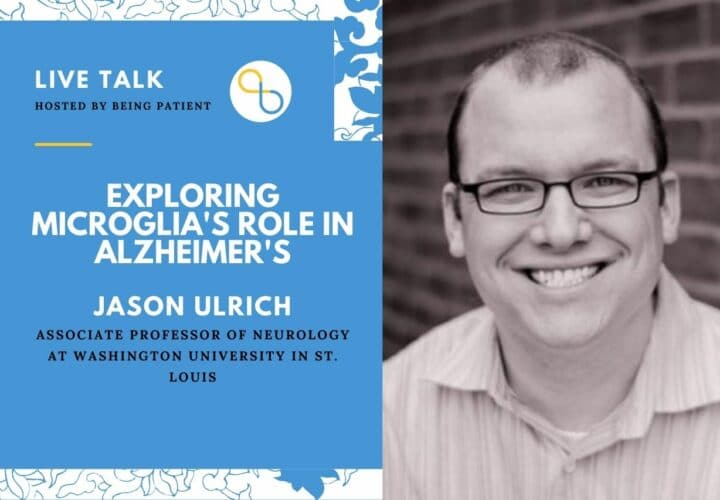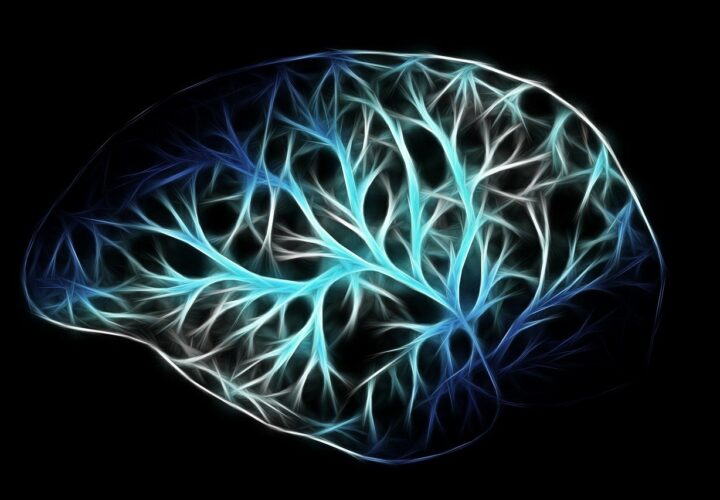Neurologist Jason Ulrich talks genetics, Alzheimer's biomarkers, and the brain's primary immune cells — microglia.
Scientists are looking toward microglia cells as therapeutic targets for Alzheimer’s. Microglia, known as the janitors of our brains, are responsible for clearing harmful debris, such as plaques and damaged neurons. With discoveries of genetic risk factors that are linked to these immune cells and the disease, researchers have found that microglia could play an intricate role in Alzheimer’s pathology. So, efforts are underway to develop microglia-targeted drugs to protect the brain from the ravages of the disease.
In our LiveTalk series, Being Patient spoke with Jason Ulrich, associate professor of neurology at Washington University in St. Louis, about how microglia is implicated in Alzheimer’s, the ways these immune cells interact with genetics and hallmark proteins of the disease known as beta-amyloid (Abeta) and tau, and avenues for future research and drug development.
Being Patient: What are microglia cells?
Jason Ulrich: Microglia are what is called a resident immune cell in the brain. It’s part of the innate immune system, which isn’t antibody- and antigen-specific but it’s just a general defense mechanism. There has been a lot of identification of genetic risk factors for late-onset Alzheimer’s disease in the past 10 years or so, and one common feature of a lot of those genetic risk factors is that there are genes that are found specifically expressed within microglia in the brain. This is pointing to the role for the cell type in the brain as somehow affecting the disease process.
Being Patient: Microglia is a subtype of glial cells. Can you explain what glial cells are and the functions of the various subtypes of glial cells?
Jason Ulrich: If you think of your brain [and] cut it into two parts, you have your neurons, which fire action potentials and signal to each other, and then you have a host of other cell types in the brain that are also extremely important. Those are called glia and you can break down glia into different subtypes. There are cells called astrocytes, which do any number of functions: supporting neurons through providing energy sources or clearing out transmitters. You have cells like oligodendrocytes, which form that white matter myelination around axons. And you have microglia, which provide that innate immune defense and can also be involved in shaping how neurons communicate with each other through clearing out synapses that aren’t used and things like that.
Being Patient: As you and co-author David Holtzman wrote in an article for the Scientific American, more than a century ago, Dr. Alois Alzheimer observed changes in glial cells’ structures in a woman’s brain with what we now call Alzheimer’s. Can you tell us more about his observations?
Jason Ulrich: [Dr. Alzheimer] noted what we now know as amyloid plaques, which are those deposits of the peptide called Abeta that form in the brain very early on in the development of the disease, and he noted inclusions of what we now know is a protein called tau, which form these fibrils inside neurons and that’s correlated with the advanced stages of the disease.
One thing he noted that took a backseat for a number of decades was that there were changes in the glial cells, what we now know are microglia or astrocytes around that amyloid plaque that he found. There were increases in fats within these cells and changes in their structure. They didn’t have stains back then like we do now with antibody stains and everything else to identify specific proteins.
Being Patient: Why do you think microglia’s role in Alzheimer’s took a backseat and didn’t receive as much focus as amyloid and tau?
Jason Ulrich: Alzheimer’s is a big problem. Working on those two proteins that start aggregating is a very logical place to start. Understanding how Abeta plaques form, how tau tangles form, how those relate to each other and how these proteins are made and degraded is very important. Until the identification of some of these genetic risk factors expressed within microglia, it wasn’t entirely clear if the microglial response was simply secondary to the development of the Abeta and tau pathologies, or whether [microglia] were actually participating somehow.
Being Patient: What are the genetic risk factors that have been shown to be related to microglia and Alzheimer’s?
Jason Ulrich: There have been several. The most important one that transformed the field of microglial research in AD (Alzheimer’s disease) was a gene called TREM2 (Triggering Receptor Expressed On Myeloid Cells 2). This is expressed within microglia only in the brain. It’s also expressed in different peripheral innate immune cells that serve similar functions in their respective organs. Within the brain, some researchers identified mutations in this gene that decreased the gene’s function. The gene had previously been implicated in another disease, a very rare disease called Nasu-Hakola disease, which is a very early-onset form of dementia. Nasu-Hakola was just a complete loss of function knockout. [For TREM2 mutations identified in Alzheimer’s], if you only had one copy of a slighter loss of function mutation, it increased your risk of developing Alzheimer’s about three- to four-fold.
Want to learn more about clinical trials
for Alzheimer’s and dementia?
Check out the Lilly Trial Guide.
A lot of people started working on this and trying to understand how losing TREM2 function within microglia could influence this disease. One of the first experiments that was done was to take our mouse models of Alzheimer’s disease. Now, there’s no true mouse model of Alzheimer’s disease because there’s not a mouse that gets amyloid, tau and neurodegeneration, but you can model different aspects of the disease in mice.
One of the tools we have are mice that develop amyloid plaques. They’ve been engineered using human proteins to develop these plaques. Normally, you get microglial clustering around the amyloid plaques. It’s not entirely clear what they’re doing but you see a lot of microglia around the plaques and they definitely respond to [the plaques] and this is seen in human AD as well.
[In] mice that don’t express TREM2, we found that clustering was totally gone. It was like the microglia weren’t seeing the amyloid at all. We observed this and many other labs around the world have observed this, and this seems to be one of the major phenotypes of this loss of function.
Being Patient: What’s the relationship between TREM2 and tau pathology then?
Jason Ulrich: Now, it gets extremely complicated. Take a mouse model of tau pathology, what we have found in our studies is if you have a mouse model that develops tau tangles and neurodegeneration, [and] if you cross those to a mouse that doesn’t have TREM2, you actually see reduced neurodegeneration. Generally within our tau mouse model when the microglia are in the presence of this tau pathology and neurodegeneration, they become very activated. They express a lot of genes that are responding to the damage. This is driving a lot of the neurodegeneration in this mouse model.
When you knock out TREM2, you don’t see that change in gene expression and it’s actually protective in a tau mouse.
One facet of tau that we’ve come to understand within the past 15 years or so is that it can template its own misfolding. You can take a misfolded species of tau and it’ll corrupt other tau that is normally folded and doing its job in the brain. If you inject one of these bad seeds into a mouse with amyloid, but no TREM2, it dramatically increases the amount of tau pathology around amyloid plaques, suggesting that part of what TREM2 is doing is to protect the brain around the plaque from allowing this misfolded tau to accumulate in Alzheimer’s disease.
Another group led by David Hansen published that if you had a mouse that was genetically engineered to express both amyloid and tau pathology, [and] knocked out TREM2, the tau pathology became far greater, far earlier than if you had TREM2. There seems to be something going on with how TREM2 is mediating that relationship between amyloid and tau pathology.
Being Patient: What are the most important questions that need to be answered about microglia’s role in Alzheimer’s in order to develop effective treatments?
Jason Ulrich: Probably the number one issue with developing a therapy that would target microglia is what would you want to do to the microglia, at which stage of the disease. If we just take our preclinical mouse data at face value, it would suggest that with amyloid, if you don’t have TREM2, you get more damage.
Maybe if an individual has amyloid plaques but hasn’t progressed to a lot of tau pathology in the brain, you’d want to activate TREM2 [and] drive that protective microgliosis around the plaque. If an individual had started to develop tau pathology, would that still be effective or would that actually make things worse? That’s an open question that we don’t really understand yet. Microglia are a tricky cell to target. There are some folks working on clinical trials in humans using antibodies that turn on TREM2 to try and figure out what’s going on.
Being Patient: Your lab is also developing antibodies targeting microglia?
Jason Ulrich: I’m the co-inventor on a patent for a TREM2 agonist antibody along with my PI (principal investigator) David Holtzman and a staff scientist in the lab. Our goal is to see what effects turning on TREM2 in amyloid and tau models has on neurodegeneration or amyloid pathology in microgliosis.
Being Patient: How do antibodies targeting microglia work differently than Aduhelm (aducanumab), the anti-amyloid antibody that was recently approved by the Food and Drug Administration?
Jason Ulrich: An anti-Abeta antibody like Aduhelm is designed to target the plaque in the brain, to bind that antibody to plaque, and then the antibody has [an] effector function, which is going to attract the microglia to the plaque and they’re going to chew up the plaque.
(In February 2024, Biogen took Aduhelm off the market indefinitely.)
The way that a TREM2 antibody would work would be a little different, in that you would be targeting TREM2 on the microglia to turn on a signal. It’s not entirely clear how TREM2 gets turned on, but what we think is going on is that if you get enough of the proteins in one area together, they turn on that way. One way you could do that is with [an] antibody. [An] antibody has two arms so you bring a bunch of TREM2s together and it turns on the signaling. In that way, you’d be modulating how those microglia are responding to plaques, and trying to make them respond in a favorable, protective way to prevent damage to, say surrounding axons or things like that.
The interview has been edited for length and clarity.
Contact Nicholas Chan at nicholas@beingpatient.com
UPDATE: 3 March 2024, 9:42 P.M. ET. In February 2024, Biogen took Aduhelm off the market, citing financial concerns. Although the drug did receive accelerated, conditional FDA approval for the treatment of early Alzheimer’s disease in 2021, it is no longer available to new patients. The company announced it would sunset trials in May 2024 and cease supplying the drug to current patients in November 2024.


